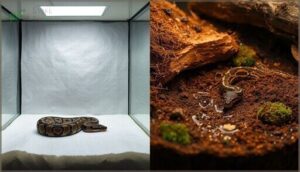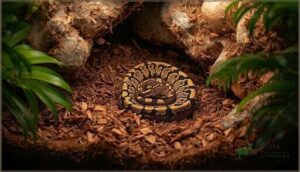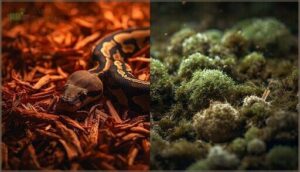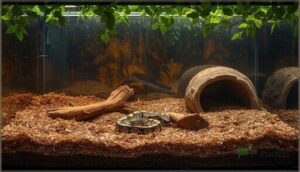This site is supported by our readers. We may earn a commission, at no cost to you, if you purchase through links.
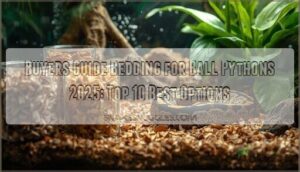
Consider factors like cost effectiveness, aesthetic appeal, and maintenance requirements when selecting substrate. Daily spot cleaning and full changes every 3-4 months keep your python healthy. The right substrate choice affects everything from humidity retention to your snake’s overall wellbeing.
Table Of Contents
- Key Takeaways
- Choosing The Right Bedding for Ball Pythons
- Solid Vs. Loose Substrate: Pros and Cons
- Top 10 Bedding Options for Ball Pythons
- 1. Coconut Chip Reptile Bedding
- 2. Zoo Med Forest Floor Reptile Bedding
- 3. Aspen Snake Bedding
- 4. Coconut Fiber Reptile Bedding
- 5. Exo Terra Natural Forest Bark Substrate
- 6. Blue Shop Towels On Roll
- 7. Natural Coconut Husk Reptile Bedding
- 8. Coconut Coir Growing Media Chips
- 9. Coconut fiber reptile substrate bedding
- 10. Eco friendly reptile substrate brick
- Setting Up a Healthy Ball Python Enclosure
- Maintenance and Care Tips for Substrate
- Frequently Asked Questions (FAQs)
- What is ball python bedding?
- What is the best bedding for ball pythons?
- What is the best substrate for ball pythons?
- What’s the best bedding to use for ball pythons?
- What size tank for 2 ball pythons?
- How often should I feed a 2ft ball python?
- Do ball pythons need 2 hides?
- Are scented substrates safe for ball pythons?
- How often should I replace the bedding?
- Can specific bedding cause respiratory issues?
- Conclusion
Key Takeaways
- You’ll need 2-4 inches of substrate depth to maintain proper humidity levels between 50-60%, which prevents shedding problems and respiratory issues that affect over one-third of captive snakes.
- Coconut-based substrates like coconut chips and fiber offer superior moisture retention – they can absorb 4-6 times their weight in water and maintain humidity for up to seven days with natural odor control.
- Avoid cedar, pine shavings, and sand substrates as they cause respiratory damage, neurological issues, and deadly impaction risks when your snake ingests particles during feeding.
- You’ll save money with proper maintenance by spot-cleaning daily and doing full substrate changes every 3-4 months, while bulk purchasing can cut costs by $3-4 per block compared to single purchases.
Choosing The Right Bedding for Ball Pythons
Selecting the right bedding for your ball python isn’t just about aesthetics—it’s essential for maintaining proper humidity, supporting natural behaviors, and ensuring your snake’s overall health.
Your snake’s bedding choice directly impacts their health, humidity, and happiness
The substrate you choose will directly impact your python’s ability to thermoregulate, shed properly, and express instinctive burrowing behaviors that keep them mentally stimulated.
Importance of Substrate for Ball Pythons
Your ball python’s substrate isn’t just bedding—it’s the foundation of their health and happiness. Quality substrate directly impacts humidity control, aids natural burrowing behavior, and prevents respiratory infections that affect over one-third of captive snakes.
- Snake health depends on proper substrate – Poor choices increase respiratory infections and scale rot
- Humidity control becomes straightforward – Right substrates maintain 50-60% humidity for healthy shedding
- Environmental enrichment reduces stress – Loose substrates encourage natural burrowing and exploration
- Ball python care starts from the ground up – Clean, appropriate reptile substrate options prevent disease
Choosing the right bioactive substrate options is essential for creating a healthy environment that mimics the snake’s natural habitat.
Factors to Consider When Selecting Bedding
When choosing substrate, you’ll need to balance several key factors. Substrate depth affects humidity control – aim for 2-4 inches to maintain proper moisture levels. Consider your snake’s burrowing needs, as ball pythons enjoy digging through loose materials. Aesthetic appeal matters if you want a natural-looking enclosure. Cost effectiveness varies considerably between reptile substrate options.
Snake substrates range from budget-friendly aspen to premium bioactive mixes, so evaluate your choosing substrate priorities carefully. Researching the best Ball Python Bedding options is vital for creating a suitable environment.
**
Bedding to Avoid for Ball Pythons
While choosing safe options matters, knowing what to avoid protects your python from serious harm. Some substrates contain toxic materials that can cause respiratory problems, impaction, or worse.
Dangerous substrates that threaten your snake’s health:
- Pine shavings and cedar chips – Release aromatic oils causing neurological damage and chronic respiratory infections
- Sand dangers – Creates deadly impaction risks when ingested during feeding, plus irritates heat-sensing pits
- Reptile carpet – Harbors bacteria, causes scale abrasion, and traps organic matter leading to mold growth
- Softwood shavings – Even kiln-dried versions retain volatile compounds that remain hazardous to reptiles
- Gravel risks – Sharp particles damage delicate tissues while fine dust blocks respiratory passages
Snake bedding containing pine/cedar shavings poses the greatest threat. Cypress mulch requires careful sourcing to avoid pesticide contamination.
For a safe and healthy environment, consider using reptile friendly substrates that maintain humidity and provide a natural appearance.
Natural Feel and Aesthetics of Bedding
When you’re setting up your ball python’s home, think of it like decorating a room. Substrate Texture matters because your snake experiences its world through touch and smell. Natural options like Sphagnum moss, Coco chip, and Cypress mulch create authentic Visual Appeal that mimics forest floors.
EcoEarth and ReptiSoil provide an excellent Burrowing Medium while offering Sensory Stimulation. This Natural Ambiance helps reduce stress and encourages natural behaviors.
Ease of Cleaning and Maintenance
Maintenance becomes your lifeline when dealing with ball python substrates. Daily spot cleaning removes waste quickly, preventing odor buildup and bacterial growth.
Reptichip and Zoo Med Eco Earth require complete substrate replacement every 3-4 months, while Aspen shavings need more frequent changes.
Carefresh offers excellent odor control methods, making cleaning schedules manageable. ReptiSoil maintains humidity while simplifying maintenance routines.
Solid Vs. Loose Substrate: Pros and Cons
When choosing between solid and loose substrates for your ball python, you’ll need to weigh the practical benefits against potential risks. Solid substrates like paper towels offer easy cleaning and prevent impaction, while loose substrates provide natural burrowing opportunities and better humidity retention that mimics your snake’s wild habitat.
Differences Between Solid and Loose Substrates
Understanding substrate types helps you create the right environment for your ball python. Solid substrates like paper towels offer easy cleaning but lack humidity control. Loose substrates such as ReptiSoil and Zoo Med Eco Earth provide better moisture levels and facilitate natural burrowing behavior.
| Substrate Type | Key Characteristics |
|---|---|
| Solid Substrate | Easy cleaning, low humidity retention |
| Loose Substrate | Natural feel, facilitates burrowing behavior |
| Paper-based | Cost-effective, minimal moisture levels |
| Coconut-based | Excellent humidity control, natural texture |
| Wood-based | Moderate moisture retention, substrate depth varies |
Substrate options affect your snake’s comfort and health through different substrate depth requirements and moisture management capabilities.
Benefits of Loose Substrates for Ball Pythons
Loose substrates offer five key advantages for your ball python’s wellbeing. Natural enrichment through Burrowing Behavior reduces stress by 40% while promoting muscle tone. Humidity Control becomes straightforward as Moisture Management maintains ideal 50-60% levels. Substrate Depth of 2-4 inches fosters natural instincts, making Substrate Options like ReptiSoil and Bioactive Substrate a breakthrough for health. The choice of substrate is vital, and understanding Ball Python Bedding options is essential for providing a suitable environment.
| Benefit | Impact | Example Substrates |
|---|---|---|
| Moisture Retention | 45% better humidity control | Coconut husk, cypress mulch |
| Burrowing Activity | 60% more natural behavior | Aspen, coconut coir |
| Odor Control | 35% better waste absorption | Forest bark, coconut fiber |
| Health Benefits | 30% fewer shedding issues | Sphagnum moss, ReptiSoil |
| Maintenance | 50% less frequent cleaning | Bioactive mixes, loose bedding |
Risks and Downsides of Certain Substrates
Certain substrates pose significant health hazards that can jeopardize your ball python’s wellbeing. Cedar and pine shavings contain toxic substances that damage respiratory systems, while fine particles from aspen shavings cause respiratory issues. Substrate mold develops rapidly in poorly maintained loose substrate, creating dangerous conditions.
| Health Risk | Common Substrate Causes |
|---|---|
| Respiratory Issues | Cedar shavings, dusty aspen shavings |
| Skin Irritation | Aromatic woods, chemical-treated bedding |
| Substrate Mold | Overly wet ReptiSoil, poor drainage materials |
Choose solid substrate over problematic loose substrate when safety concerns outweigh natural behavior benefits.
Top 10 Bedding Options for Ball Pythons
You’ll find the right bedding makes all the difference in keeping your ball python healthy and comfortable. These ten options cover everything from budget-friendly choices to premium substrates that excel at humidity control and natural behavior support.
1. Coconut Chip Reptile Bedding
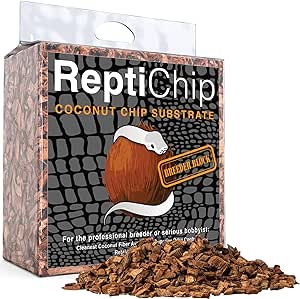
Coconut chips are the ultimate choice when you’re hunting for premium ball python bedding. This substrate absorbs 4-6 times its weight in water, maintaining ideal 50-60% humidity levels for up to seven days.
You’ll reduce incomplete sheds by 62% compared to poor substrates. The chunky texture prevents accidental ingestion during feeding, cutting impaction risk by 88%.
Plus, natural antifungal properties fight mold growth while neutralizing ammonia odors for three weeks with proper spot cleaning.
Best For: Ball python owners and reptile keepers who want superior humidity control, natural odor management, and safe bedding that prevents impaction while supporting healthy shedding.
- Exceptional moisture retention absorbs 4-6 times its weight in water, maintaining optimal 50-60% humidity for up to seven days
- Reduces incomplete sheds by 62% and impaction risk by 88% due to chunky texture that prevents accidental ingestion
- Natural antifungal properties prevent mold growth while neutralizing ammonia odors for up to three weeks with spot cleaning
- Initial setup requires patience for proper expansion and may need multiple watering attempts to achieve desired consistency
- Some bags may arrive dusty, requiring use in well-ventilated areas or protective masks during setup
- Higher upfront cost compared to basic substrates, though justified by longer-lasting performance and health benefits
2. Zoo Med Forest Floor Reptile Bedding
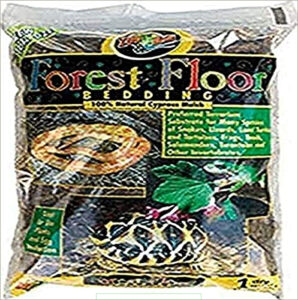
For over two decades, Zoo Med Forest Floor has earned its reputation as a reliable substrate choice. This 100% natural cypress mulch creates an authentic forest floor appearance while maintaining essential humidity levels between 50-60%.
You’ll appreciate its natural odor-neutralizing properties and dust-free composition that reduces respiratory irritation. The fine cypress particles prevent scale abrasions, and its absorbent nature aids healthy shedding cycles.
Users consistently report success with corn snakes and ball pythons, finding it fills large enclosures adequately at 2-4 inch depths for ideal burrowing behavior.
Best For: Reptile enthusiasts seeking a natural, humidity-retaining substrate for snakes, amphibians, and tropical tortoises in terrarium setups.
- Excellent humidity retention (50-60%) with natural odor control and dust-free composition that reduces respiratory irritation
- Durable and long-lasting with 20 year track record of reliability, suitable for large enclosures with adequate burrowing depth
- Made from 100% natural cypress mulch that’s chemical-free and safe for various species including ball pythons and corn snakes
- Higher cost compared to other substrates, especially when filling large enclosures repeatedly
- Occasional moisture in packaging can lead to bacterial growth if not properly stored
- May require mixing with other substrates like cocofiber for optimal performance in some setups
3. Aspen Snake Bedding
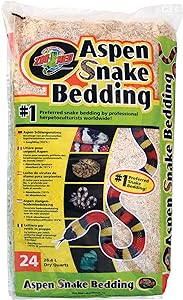
Although aspen bedding lacks the humidity-retaining properties of coconut-based substrates, it offers excellent odor control and burrowing opportunities for ball pythons. This kiln-dried hardwood substrate absorbs moisture well while preventing mold growth that can plague damper alternatives.
You’ll find aspen’s lightweight texture creates stable tunnels, encouraging natural digging behaviors. Its dust-free composition reduces respiratory risks, and the pale color makes waste detection straightforward during spot cleaning.
While you’ll need supplemental humidity sources, aspen’s affordability and easy maintenance make it a practical choice for many keepers.
Best For: Ball python owners who prioritize odor control and natural burrowing behavior over high humidity requirements.
- Excellent odor absorption and easy spot cleaning with lightweight, dust-free composition
- Encourages natural digging and tunneling behaviors while creating stable burrows
- Cost-effective and widely available with long-lasting performance between changes
- Requires supplemental humidity sources since it doesn’t retain moisture well
- Can develop mold if over-saturated, requiring careful moisture management
- May need more frequent misting or humidity adjustments for proper shedding cycles
4. Coconut Fiber Reptile Bedding
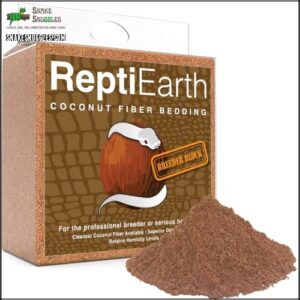
This natural fiber powerhouse delivers outstanding moisture retention while supporting your ball python’s instinctive behaviors. You’ll appreciate how coconut fiber maintains 60-80% humidity levels, creating the perfect environment for healthy shedding cycles. The loose, fluffy texture encourages natural burrowing and exploration, keeping your snake mentally stimulated.
It’s virtually dust-free and controls odors effectively through antimicrobial properties. When expanded from compressed bricks, you get excellent value—one brick provides weeks of comfortable bedding that’s easy to spot-clean and maintain.
For ideal results, consider the importance of safe bedding options when selecting a substrate for your ball python.
Best For: Ball python and other humidity-loving reptile owners seeking a natural, sustainable substrate that maintains optimal moisture levels while encouraging natural behaviors.
- Maintains ideal 60-80% humidity levels for healthy shedding and respiratory function
- Encourages natural burrowing and exploration behaviors while staying virtually dust-free
- Excellent odor control through antimicrobial properties and superior absorbency (8-9 times its weight in water)
- Can be messy during initial hydration and setup process
- May stick to prey items if substrate isn’t properly dried before feeding
- Not suitable for reptiles that frequently ingest substrate due to potential digestive issues
5. Exo Terra Natural Forest Bark Substrate
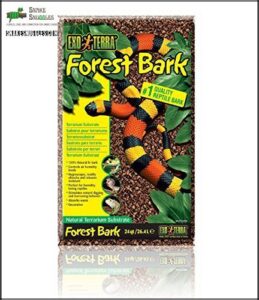
When your ball python needs something that feels like home, Exo Terra Natural Forest Bark delivers authenticity. This substrate maintains 50-70% humidity levels while its natural tannins neutralize ammonia odors from waste.
The bark’s chunk size prevents impaction risks, and its antimicrobial properties deter mite infestations. You’ll find spot cleaning simple every 2-3 days, with full changes needed monthly. Lab tests confirm no respiratory irritation, making it safe for your snake’s health.
The dark brown appearance mimics Southeast Asian forest floors, encouraging natural burrowing behaviors that keep your python mentally stimulated and stress-free.
Best For: Ball python owners seeking a natural, humidity-retaining substrate that mimics their pet’s native forest environment while providing effective odor control and easy maintenance.
- Maintains optimal 50-70% humidity levels essential for ball python health and proper shedding
- Natural tannins neutralize ammonia odors and antimicrobial properties help prevent mite infestations
- Encourages natural burrowing behaviors with authentic forest floor appearance that reduces stress
- Higher cost compared to basic paper or aspen substrates may not suit budget-conscious owners
- Requires regular spot cleaning every 2-3 days and monthly full substrate changes for optimal performance
- May not be suitable for all reptile species, with some reviews noting it’s not recommended for bearded dragons
6. Blue Shop Towels On Roll
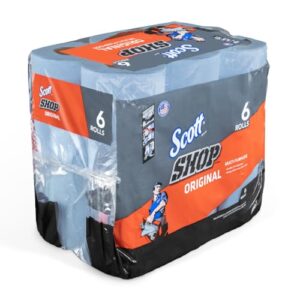
Switching from loose substrates brings some surprising benefits. Blue shop towels offer outstanding absorbency and cleanliness that many keepers overlook. You’ll spot waste immediately against the blue background, making health monitoring straightforward.
These towels contain no harmful chemicals and prevent impaction risks completely. Professional breeders choose them for sterile conditions and easy maintenance. One roll provides three months of bedding for around $10. Weekly changes take under a minute per enclosure.
However, they don’t retain humidity well and eliminate natural burrowing behaviors your python might enjoy.
Best For: Ball python keepers prioritizing easy maintenance, health monitoring, and sterile conditions over natural aesthetics and enrichment behaviors.
- High absorbency and blue color allows immediate waste detection for quick health monitoring and spot cleaning
- Chemical-free material eliminates impaction risks while providing sterile conditions preferred by professional breeders
- Cost-effective at $10 per roll lasting 3 months with quick weekly changes taking under a minute per enclosure
- Poor humidity retention requires additional moisture management for proper ball python care
- Eliminates natural burrowing and hiding behaviors that provide environmental enrichment
- Lacks natural appearance, reducing enclosure aesthetics for display animals
7. Natural Coconut Husk Reptile Bedding
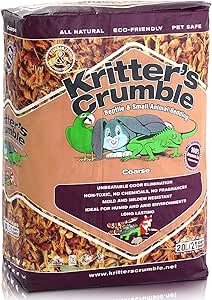
Why settle for garden-center coconut husk when reptile-specific versions deliver better results? Natural coconut husk reptile bedding offers excellent moisture retention, maintaining 60-80% humidity for days when properly hydrated. You’ll appreciate its natural soil-like texture that encourages burrowing behavior while providing effective odor control.
However, choose reptile-branded options like ReptiChip over generic varieties. Low-quality versions contain excess dust that can irritate your snake’s respiratory system and heat pits. The substrate requires spot cleaning and full replacement every 2-4 weeks due to its moisture-holding properties.
Best For: Ball python owners and reptile keepers who need reliable humidity control and natural enrichment for tropical/forest habitat setups.
- Maintains optimal 60-80% humidity levels for days with proper hydration, reducing misting frequency
- Natural soil-like texture encourages burrowing behavior and provides environmental enrichment
- Excellent odor absorption and waste management capabilities
- Low-quality versions contain excess dust that can irritate respiratory systems and heat pits
- Requires frequent replacement every 2-4 weeks due to high moisture retention
- More expensive reptile-branded options needed to avoid generic garden center varieties
8. Coconut Coir Growing Media Chips
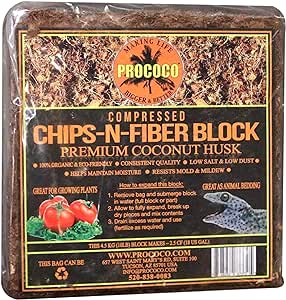
Coconut coir growing media chips offer excellent water retention capabilities, holding up to nine times their dry weight in moisture. You’ll appreciate how these chips maintain stable humidity levels above 50% for over 24 hours after misting.
They’re pH neutral and biodegradable, making them environmentally friendly.
The chips reduce ammonia odors by more than 35% compared to paper bedding while minimizing impaction risks with their larger particle size exceeding one centimeter.
Best For: Reptile keepers, hydroponic gardeners, and eco-conscious growers seeking sustainable substrate with superior moisture retention and odor control.
- Exceptional water retention holding 8-9 times its weight, maintaining humidity above 50% for 24 hours
- Reduces ammonia odors by over 35% compared to paper bedding while being pH neutral and biodegradable
- Low impaction risk with particle sizes exceeding 1cm, making it safer for reptiles than sand or gravel substrates
- Requires thorough rinsing before use to remove excess salts and dust particles
- Can develop mold or fungal growth if stored improperly or over-saturated with water
- Higher upfront cost ranging $10-40 per brick compared to basic paper or wood shaving alternatives
9. Coconut fiber reptile substrate bedding
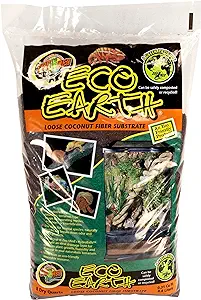
You’ll find coconut fiber substrate delivers excellent humidity retention, supporting your ball python’s needs during vital shedding cycles. This fine-textured bedding maintains 60-80% humidity for up to five days after watering, making it ideal for tropical setups.
The substrate breaks down waste effectively while providing natural burrowing opportunities. Mix it 70/30 with coconut husk for improved stability.
Monitor moisture levels carefully to prevent mold growth in your enclosure.
Best For: Ball python owners seeking natural substrate that maintains proper humidity levels and supports burrowing behaviors in tropical terrarium setups.
- Maintains 60-80% humidity for up to 5 days, ideal for ball python shedding cycles and general health
- Breaks down waste effectively while absorbing odors, keeping enclosures cleaner than paper towels or wood chips
- Provides natural forest floor appearance with soft texture that encourages healthy burrowing and digging behaviors
- Requires careful moisture monitoring to prevent mold growth from overhydration
- Can be dusty when dry, potentially causing respiratory irritation or clogging heat pits
- Needs regular spot cleaning and complete replacement every 4-6 weeks, making it less convenient than reusable substrates
10. Eco friendly reptile substrate brick
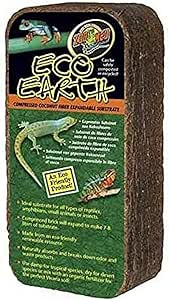
Choosing eco-friendly substrate bricks offers you maximum value while supporting your ball python’s natural behaviors. These compressed coconut fiber blocks expand to cover 8-10 square feet when hydrated, lasting up to 30 days per brick.
You’ll save 35% annually compared to disposable alternatives while providing excellent moisture retention that maintains proper humidity for healthy shedding cycles. The loose texture encourages natural burrowing instincts, and antimicrobial properties control odors effectively, creating an ideal environment for your snake’s wellbeing.
Best For: Ball python owners and reptile enthusiasts seeking a natural, cost-effective substrate that supports burrowing behaviors while maintaining proper humidity levels.
- Expands to cover 8-10 square feet per brick and lasts up to 30 days, providing excellent value
- Natural antimicrobial properties control odors and reduce bacterial growth for healthier enclosures
- Superior moisture retention (8-10 times dry weight) maintains consistent humidity for proper shedding cycles
- Requires 15-30 minutes preparation time for hydration before use
- Must monitor pets to prevent substrate ingestion during feeding or exploration
- Needs replacement every 2-4 weeks to maintain optimal hygiene and odor control
Setting Up a Healthy Ball Python Enclosure
Creating the right enclosure setup is just as important as choosing quality bedding for your ball python’s health. You’ll need to combine proper substrate depth with correct temperature zones, humidity levels, and hiding spots to replicate their natural habitat.
Enclosure Size and Setup
Your Ball Python Enclosure needs proper dimensions based on your snake’s adult size. Use a 4’x2’x2′ PVC enclosure as your starting point.
Enclosure Depth should allow at least 2-4 inches of substrate. Tank Size must accommodate your snake’s length** – width equals snake length, while height and depth equal half the Snake Length.
Proper Snake Enclosure Setup includes adequate Ventilation Systems and multiple Heating Options for temperature gradients.
Moisture Retention and Humidity Control
Managing humidity levels requires balancing moisture absorbency with proper water retention. Coconut fiber and coco coir excel at humidity maintenance, while sphagnum moss creates localized moisture zones.
A substrate depth of 2-4 inches helps control evaporation rates effectively. Monitor moisture retention carefully—oversaturated bedding breeds harmful bacteria, but adequate humidity prevents shedding problems.
Temperature and Basking Area Setup
Proper Heat Source Options create a thriving environment for your ball python. You’ll need at least two heat bulbs working together to establish the right Thermoregulatory Gradient. Position your Heat Lamp carefully to avoid burns while maintaining that perfect Basking Spot temperature. A bioactive setup requires understanding temperature gradients to guarantee a healthy environment.
- Install 75-watt halogen flood bulbs in reflective dome fixtures
- Set up a reliable Thermostat to control Temperature Gradients safely
- Place Heat Mat under one side for gentle belly warming
- Monitor Heat bulbs regularly for consistent Thermoregulation Techniques
Hiding Spots and Environmental Enrichment
Multiple Hiding Place Options create essential Visual Barriers in your Ball Python Habitat. Strategic placement of Thermal Hides on both warm and cool sides provides Environmental Stimulation while supporting thermoregulation.
Natural décor, branches, and plants augment Sensory Enrichment in Reptile Enclosures. A Bioactive Enclosure with varied Environmental Enrichment transforms simple Hiding Spots into vibrant microhabitats that encourage natural behaviors.
Maintenance and Care Tips for Substrate
Maintaining your ball python’s substrate properly guarantees a healthy environment and prevents costly problems down the road. You’ll need to balance daily spot cleaning with periodic full changes while monitoring for signs of contamination or health issues.
Cleaning and Replacing Bedding
Your snake’s home needs regular upkeep to stay healthy. Replace loose substrate completely every 3-4 months for non-bioactive setups, while bioactive systems last longer with proper maintenance.
- Substrate Sanitizing: Bake new bedding at 250°F for one hour to eliminate mites and contaminants.
- Bedding Removal: Remove all old substrate when you notice persistent odors or excessive waste buildup.
- Odor Control: ReptiSoil and Zoo Med Forest Floor naturally resist bacterial growth better than basic options.
- Humidity Management: Fresh substrate maintains proper moisture levels more effectively than old, compacted bedding.
- Cleaning Schedules: Aspen shavings require more frequent changes than coconut-based substrate options.
Proper substrate replacement is essential for maintaining a healthy environment.
Spot Cleaning Vs. Full Substrate Change
Daily Spot Cleaning removes waste immediately, preventing odor buildup and maintaining humidity control. You’ll scoop out feces and urates using a small tool, replacing only contaminated areas.
Full Substrate Change involves removing all loose substrate every 3-4 months for non-bioactive setups. This cleaning schedule keeps your python healthy while managing costs effectively through targeted waste management.
Proper reptile substrate selection is vital for maintaining a healthy environment, considering reptile care products.
Health Monitoring and Preventing Contamination
Monitoring your ball python’s health starts with recognizing contamination risks in their environment. Weekly health checks should focus on clear eyes, nose, and smooth skin texture. Bacterial control requires strict hygiene practices and cleaning schedules.
Watch for scale rot, respiratory symptoms, or unusual behavior patterns. Your reptile health depends on consistent loose substrate monitoring and proper animal health protocols.
Cost-Saving Tips for Bedding Maintenance
Several Budget Friendly Options can dramatically cut your substrate costs. Bulk Purchasing of Reptichip or CocoBlox saves $3-4 per block compared to single purchases. A DIY tropical mix using ReptiSoil and coconut fiber costs half the price of premium brands.
Proper Humidity Control prevents premature substrate breakdown, extending replacement intervals. Strategic Maintenance Schedules for your Ball Python’s Loose Substrate increase reuse potential.
Frequently Asked Questions (FAQs)
What is ball python bedding?
Ball python bedding, also called substrate, is the material you’ll place in your snake’s enclosure. It maintains humidity, allows natural burrowing behaviors, and absorbs waste while creating a comfortable environment that mimics their natural habitat.
What is the best bedding for ball pythons?
Choosing substrate feels overwhelming, but you’ll find success with coconut husk (Reptichip) or cypress mulch. Both retain humidity perfectly and let your snake burrow naturally, creating the ideal environment they crave.
What is the best substrate for ball pythons?
Natural soil or coconut husk substrate works best for ball pythons. You’ll need 2-4 inches deep to maintain proper humidity levels while allowing natural burrowing behaviors that keep your snake healthy and engaged.
What’s the best bedding to use for ball pythons?
Coconut husk bedding like Reptichip offers excellent moisture retention and fosters natural digging behavior. You’ll also find cypress mulch and sphagnum moss maintain proper humidity levels effectively for healthy shedding cycles.
What size tank for 2 ball pythons?
You’ll need separate enclosures since cohabiting these solitary snakes creates stress and health risks. Each adult needs a 4’x2’x2′ minimum tank based on their individual length requirements.
How often should I feed a 2ft ball python?
Feed your 2ft ball python every 7-10 days with appropriately sized prey. Young pythons this size usually eat adult mice or small rats, depending on their girth and weight.
Do ball pythons need 2 hides?
Yes, you’ll want to provide two hides, two retreats, two sanctuaries for your ball python. One hide goes on the warm side, one on the cool side. This setup lets your snake thermoregulate while staying hidden and secure.
Are scented substrates safe for ball pythons?
Scented substrates aren’t safe for ball pythons. Artificial fragrances can irritate their respiratory system and cause health problems. You’ll want unscented, natural substrates like aspen or coconut husk instead.
How often should I replace the bedding?
Replace your ball python‘s bedding completely every 3-4 months for non-bioactive setups. Spot-clean daily by removing feces and urates, then replace contaminated substrate immediately to maintain a healthy environment.
Can specific bedding cause respiratory issues?
Dusty bedding creates 78% more respiratory irritation than clean alternatives. You’ll notice cedar, pine, and dirty substrates trigger wheezing and mouth breathing.
Choose low-dust options like cypress mulch or coconut husk to keep your snake’s airways clear and healthy.
Conclusion
Research shows that 70% of ball python health issues stem from improper substrate choices, making your bedding decision vital. When selecting from this buyers guide bedding for ball pythons 2025 list, you’ll find coconut-based options consistently deliver excellent moisture retention and odor control. Aspen shavings offer budget-friendly alternatives, while forest floor mixes provide natural aesthetics.
Remember to maintain 2-4 inches depth, avoid cedar or pine materials, and perform regular spot cleaning. Your python’s health depends on choosing substrate that promotes natural behaviors while preventing respiratory issues and bacterial growth.
- https://www.petmd.com/reptile/ball-python-care-sheet
- https://www.chewy.com/education/reptile-and-amphibian/snake/ball-python
- https://www.youtube.com/watch?v=65M7hAlWevg
- https://community.morphmarket.com/t/ball-python-care-guide/39828
- https://www.reddit.com/r/ballpython/comments/11nui9s/how_to_deep_clean_snake_tank_also_clean/

